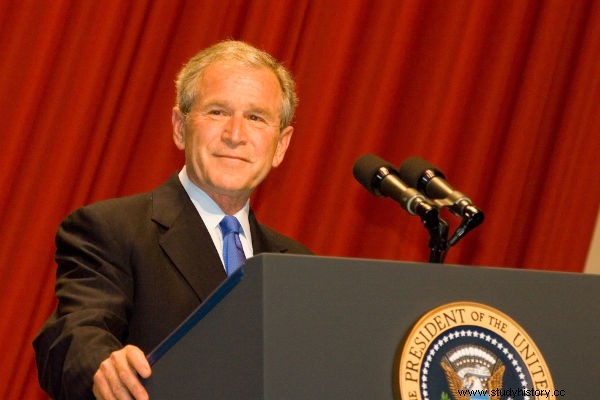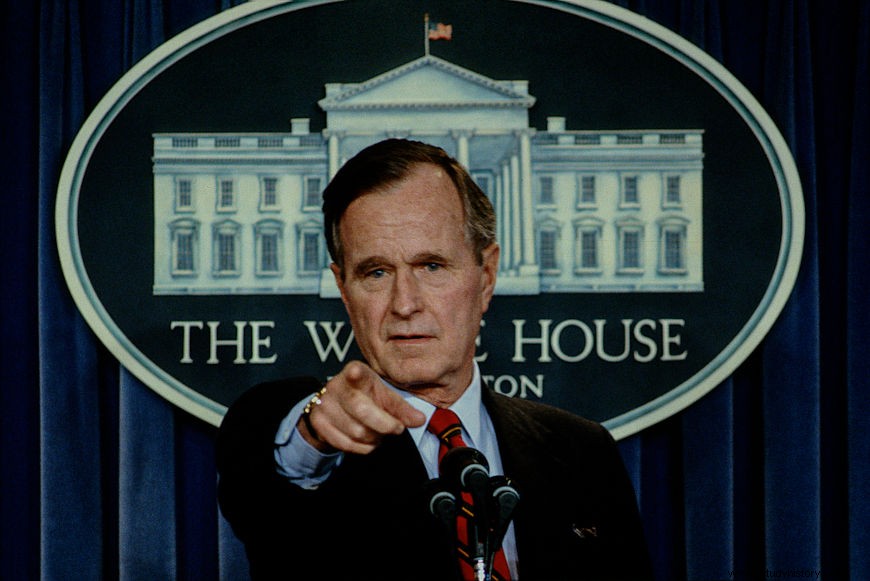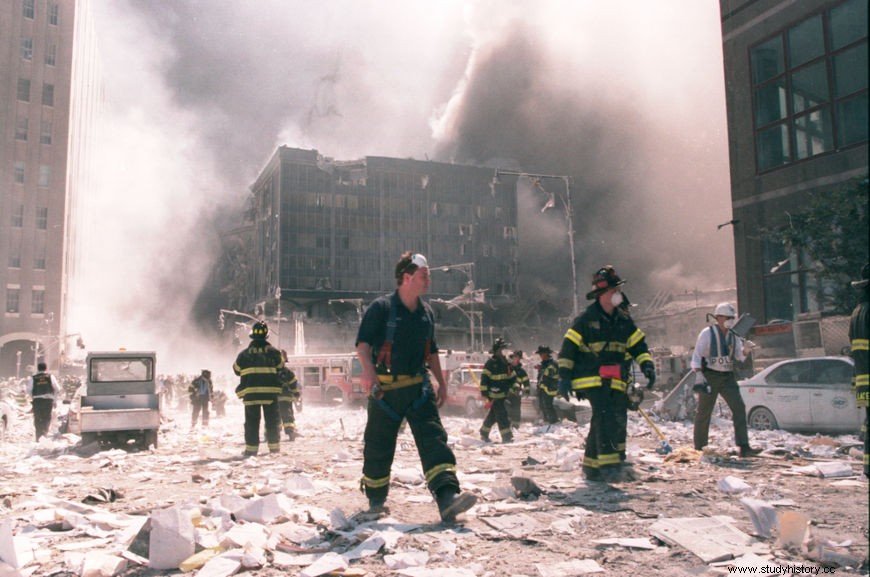
George W. Bush is internationally recognized as the 43rd US president, serving a term from 2001 to 2009. His government was marked by the attacks carried out by Al-Qaeda on September 11, 2001 and by the “war on terror” that he promoted afterwards. During his rule, Afghanistan and Iraq were invaded by the US army.
George W. Bush's Youth
George Walker Bush was born on July 6, 1946, in New Haven, Connecticut, United States. He was son of George Herbert Walker Bush , who was the 41st president of the same country, and Barbara Pierce . George W. Bush had four brothers , named John, Neil, Marvin and Dorothy.
Despite being born in Connecticut, Bush was raised in Texas , spending part of his childhood in the cities of Midland and Houston. He studied for a few years in that state, but attended High School in Massachusetts. In 1964, Bush began his graduation, going on to study at Yale University . His degree in history spanned from 1964 to 1968, and he defined himself as an average student.
Login also :Gulf War, the first US clash with Saddam Hussein
George W. Bush's Adult Life
After completing his graduation, Bush began his military career upon joining the Texas Air National Guard . He remained in that air force for six years, during which time he flew jet planes. In 1972, he was suspended from flying after missing a scheduled physical, and in 1974, he was released from service.
After being discharged from the military, Bush began an MBA in Harvard Business School , and in 1977 he started a small oil business. The company created by Bush was Arbusto Energy, which explored oil in Texas. It started its operations only in 1978.
The factor that allowed Bush's company to start operations was the defeat he suffered in the election for a position in the House of Representatives. In the race to become deputy, he was defeated by a Democratic Party candidate. In the late 1980s, as we will see, he resumed his steps towards political life.
For much of the 1980s, he devoted himself to the business of his oil company, which was renamed Bush Exploration . In 1984, his company was merged with Spectrum 7, and two years later, in 1986, it was purchased by Harken Energy. Despite this, Bush remained in important positions within the enterprise.
George W. Bush's Political Career

In 1988, George Bush and his family moved to Washington, and the purpose of that was to work on your father's political campaign , George H. W. Bush, who was running for president of the United States. Earlier, his father had held the vice presidency of the United States during Ronald Reagan's two terms.
In this election, George H. W. Bush ran for president for the Republican Party and defeated Democrat Michael Dukakis by winning 426 Electoral College votes. Four years later, George W. Bush was again working to assist his father in the election campaign, this time for reelection. However, he was eventually defeated by Bill Clinton.
In the 1990s, Bush officially decided to enter politics and announced that he would run for governor of Texas. He won the GOP primaries and was made official as the party's candidate. In that race he was elected governor of Texas by defeating Democratic candidate Ann Richards, garnering over 53% of the vote.
George W. Bush was governor of Texas until the year 2000. For that he needed to be re-elected, a feat accomplished in 1998, when he won more than 68% of the votes. That same year, his brother Jeb Bush (John Ellis Bush) managed to be elected governor of the state of Florida.
Login also :How is the president of the United States elected?
2000 Election
George W. Bush's popularity as governor of Texas made him well-suited for the US presidential race. In the GOP primaries, he was chosen as a candidate after defeating John McCain. In the race for the presidency, Bush run with Democratic candidate Al Gore , who had been Bill Clinton's vice president from 1992 to 2000.
The 2000 presidential election was one of the most disputed in American history and was decided by one of the smallest margins in the Electoral College. At the end of the count, Al Gore got 500 thousand votes more than George W. Bush, however, the latter got five more votes in the Electoral College, which made him win the race by 271 to 266 .
It is worth remembering that the presidential election in the United States is decided only by the Electoral College and not by the total number of votes. Yet George W. Bush's victory was only the fourth time in history that an elected presidential candidate had fewer votes than his opponent. . This happened again only in 2016, when Donald Trump defeated Hillary Clinton.
Bush's victory still had a lot of controversy due to the vote count in Florida. The decision of the 2000 election was awaiting the result of that state, one of the most important in the calculation. The vote gap in that state was minimal for Bush, and he won by less than two thousand votes.
Florida state law provided that if the count was decided on a minimum score, a recount should be carried out. The recount has taken place, and the difference has been reduced to 537 votes , which opened the way for Al Gore's victory to be possible. The Democratic candidate then asked for manual counting of votes.
Al Gore also sued the Florida Supreme Court to authorize a recount of votes, and his request was approved. George W. Bush, in turn, called on the US Supreme Court to stop the recount. The country's Supreme Court accepted Bush's request, and with that, Al Gore was forced to recognize the Republican's victory.
Officially, Bush won Florida by just 537 votes , a difference of less than 0.01% of the votes.
Read more: Abraham Lincoln – 16th US President whose government was marred by the American Civil War
George W. Bush presidency

Bush's presidency was marked by his g war on t error , the name adopted for the actions of his government in the fight against terrorism in the world. Bush assumed the presidency in January 2001 and, in September, an event marked his administration:the terrorist attacks promoted by Al-Qaeda on September 11 .
During these attacks, four commercial planes were hijacked by terrorists, two of which were launched against the two towers of the World Trade Center, an office building in New York; the third plane was launched against the Pentagon in Washington; the fourth plane was to be launched against the Capitol, but crashed in the Pennsylvania countryside after the passengers rebelled against the terrorists.
As a result of the attacks, a total of 2996 people died, and US domestic security policy has become much stricter. In addition, as researcher Alessandro Shimabukuro points out, US foreign policy has changed radically, and the country has started to defend democracy around the world, intervening directly against terrorism and against governments hostile to the United States| 1| .
The Bush administration found itself in an extremely delicate situation because of the attacks, but it also saw its popularity soar days after 9/11, as there was a strong society's patriotic response because of the tragedy. Bush, in turn, authorized military intervention in Afghanistan , a country dominated by the Taliban and which was home to al-Qaida bases. The invasion took place in 2001.
In 2003, on the grounds that Saddam Hussein harbored weapons of mass destruction, a new military intervention was organized, this time against Iraq. The US army invaded Iraq, occupied Baghdad and overthrew the Iraqi dictator. Saddam Hussein was later arrested, tried and sentenced to death.
In 2004, George W. Bush was elected for a second term by defeating Democrat John Kerry, 286 to 251, in the Electoral College. In 2009, he handed over the presidency to Democrat Barack Obama, winner of the 2008 presidential election.
|1| SHIMABUKURO, Alessandro. The impact of 9/11 on politics, religion and society in the United States. In.:SILVA, Carlos Eduardo Lins da (org.). One n action with the soul of i church . São Paulo:Peace and Earth, 2009. p. 157.
Image credits
[1] Joseph August and Shutterstock
[2] mark reinstein and Shutterstock
[3] Anthony Correia and Shutterstock
